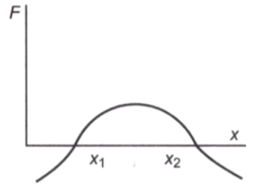Potential Energy
Potential Energy: Overview
This Topic covers sub-topics such as Potential Energy, Energy Stored in Spring, Graph of Potential Energy, Force and Potential Energy, Calculation of Potential Energy from Conservative Force and, Work Done by Conservative Forces and Potential Energy
Important Questions on Potential Energy
A particle in a certain conservative force field has a potential energy given by . The force exerted on it is
A uniform chain of length is kept on a table such that a length of hangs freely from the edge of the table. The total mass of the chain is . What is the work done in pulling the entire chain in the table?
A particle is moved from to under a force from two paths. Path is and path is . Let and be the work done by this force in these two paths. Then,
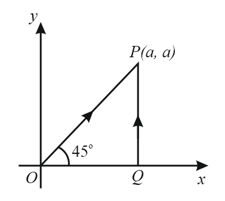
If and represent the work done in moving a particle from to along three different paths and , respectively (as shown), in the gravitational field of a point mass , find the correct relation between and .
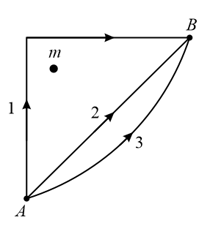
A spring long is stretched by the application of a force. If force required to stretch the spring through , then work done in stretching the spring through is
The spring constant of the spring of a gun is newton/meter. The spring has been compressed meter from its normal position and a bullet of mass has been put in the barrel. If the friction is negligible then on firing the gun, the bullet shall have a velocity of

From a fixed support , hangs an elastic string of negligible mass and natural length . Masses and attached at the lower end, elongate the string to . When is removed gently, is able to bounce back to . The ratio is (assume that the string does not obstruct the motion of )
Calculate the force associated with the following one-dimensional potential energy :-
The force acting on a body moving along axis varies with the position of the particle shown in the figure. The body is in stable equilibrium at
Select the correct Potential energy() vs inter-atomic distance() for a stable molecules found in nature.
In the given graph shown the variation of the potential energy U by the interaction between two particles, with the distance separating them, .
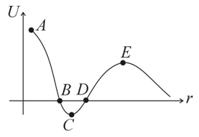
(i) is a point of stable equilibrium
(ii) and equilibrium points
(iii) The force of interaction between the particles is repulsive between points and .
(iv) The force of interaction between the two particles is attractive between points and , and repulsive between and on the curve
Choose correct statement(s)?
A particle of mass moving in the plane has its potential energy given by , and being in . Initially at ,the particle is located at the origin and moving with a velocity of . Find the magnitude of force acting on the particle.
In a uniform magnetic field of 0.15 T a short bar magnet of magnetic moment m = 0.32 J/T is placed. What is the potential energy of the magnet in unstable position , if the bar is free to rotate in the plane of the field?
Consider that the potential energy of a system is given as . After finding the equilibrium positions ,choose which of these positions is stable equilibrium
In the arrangements shown below, all the balls are identical and strings are light. There is no friction. In each of the three arrangements and , the system is in equilibrium.
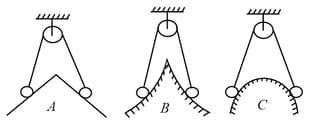
The hill slopes are identical on the two slides in each of the arrangements.
One of the balls in each arrangement is pulled down a little along the hill slope.
An inelastic ball is dropped from a height . If due to impact it loses of its energy the ball will rise to a height of
Find the work done to take a particle of mass from surface of the earth to a height equal to
A particle is moving in a force field given by potential energy from point to . The work done in the process is
The potential energy of a body of mass is . The magnitude of the acceleration of the body will be
The potential energy of a particle of mass moving in the plane is given by , where and are in meters. If , the particle starts from rest from the origin, then speed of the particle at is

